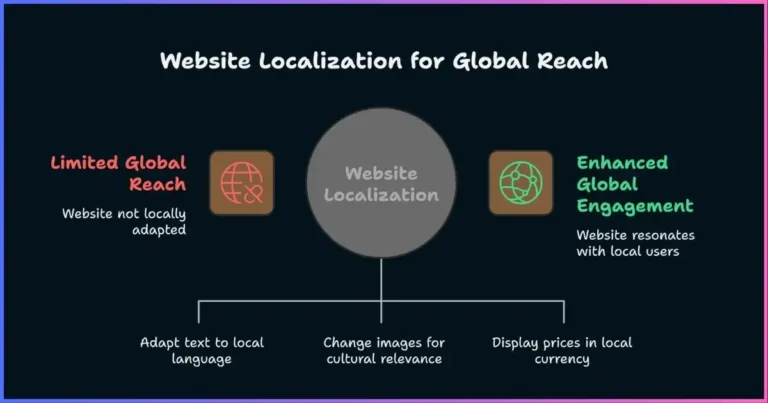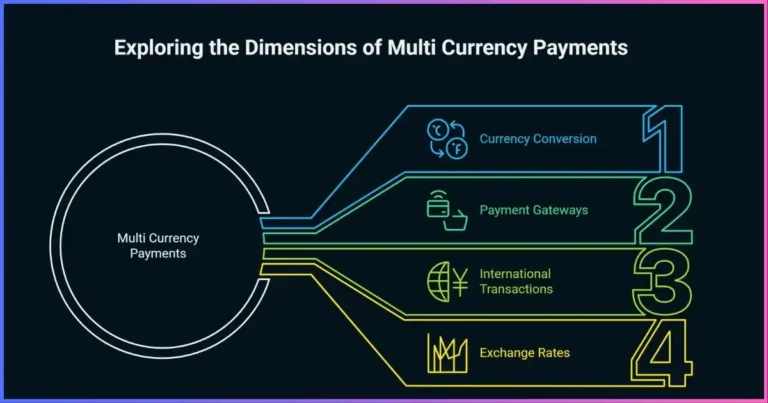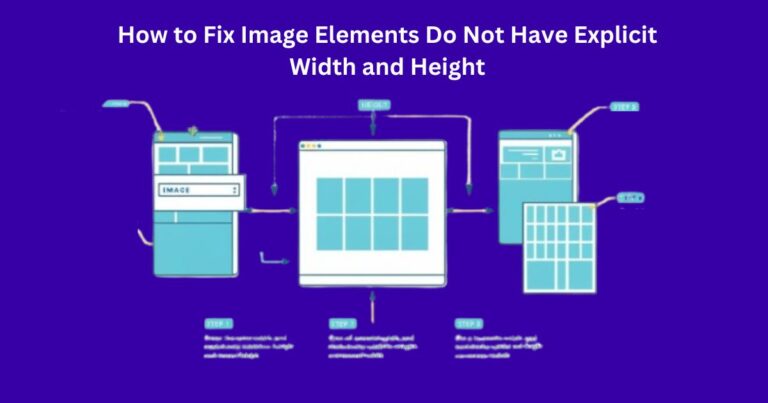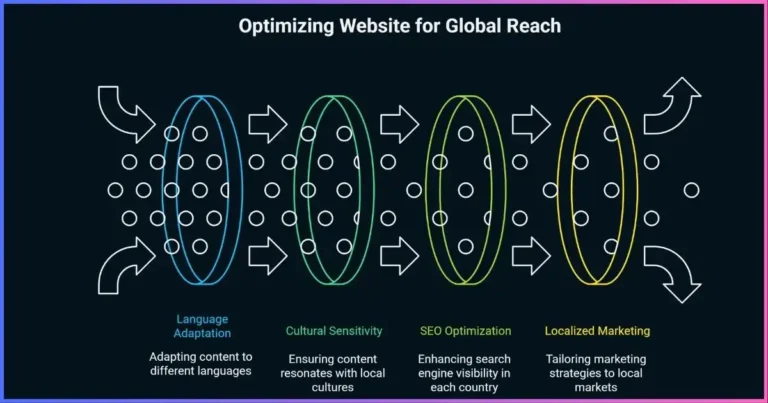Geo Targeting SEO: How to Boost Local Visibility & Conversions
The Complete Guide to Location-Based Search Optimization
Introduction to Geo Targeting SEO
Geo targeting SEO has become a cornerstone of digital marketing success, with 76% of consumers who search for local businesses visiting a physical location within 24 hours. This comprehensive guide explores how businesses can leverage location-based optimization strategies to boost local visibility, drive qualified traffic, and significantly increase conversions through targeted geographic search optimization.
In today’s competitive digital landscape, understanding and implementing effective geo targeting SEO techniques can mean the difference between being discovered by your ideal customers or remaining invisible in search results. This article covers everything from fundamental concepts to advanced implementation strategies, providing actionable insights backed by current industry statistics and proven methodologies.
Whether you’re a local business owner, digital marketer, or SEO professional, you’ll discover how to harness the power of geographic targeting to improve your search rankings, enhance user experience, and drive measurable business growth through location-specific optimization techniques.
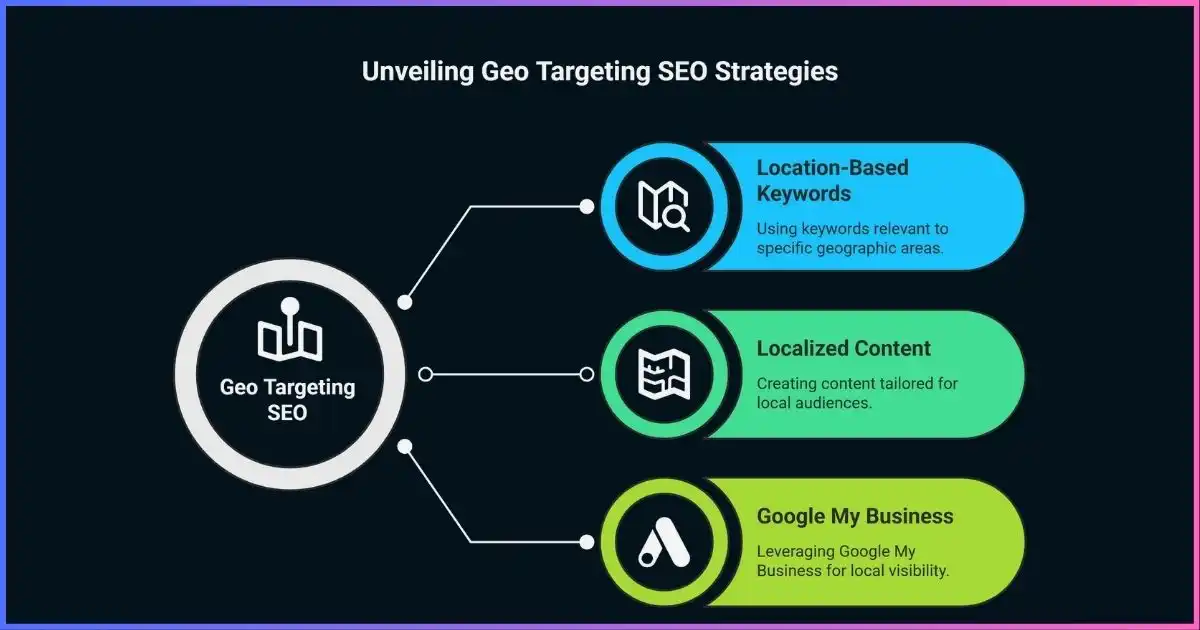
Understanding Geographic Search Behavior
Local Search Statistics
The importance of geo targeting SEO becomes clear when examining current search behavior patterns. Recent studies reveal compelling statistics about how consumers interact with location-based searches and the business impact of effective geographic optimization.
Local Search Behavior Statistics
Mobile vs Desktop Local Search Distribution
Key Search Patterns
- 97% of users search online for local businesses
- 88% of local mobile searches result in action within 24 hours
- 72% of consumers visit stores within 5 miles of their location
- 54% of smartphone users search for business hours
Consumer Intent Indicators
- “Near me” searches increased by 500% over two years
- 76% of local searches result in phone calls
- 28% of local searches result in purchases
- 50% of users visit a store within one day of local search
Core Geo Targeting SEO Strategies
Implementing effective geo targeting SEO requires a multi-faceted approach that addresses technical optimization, content strategy, and user experience. The following strategies form the foundation of successful location-based search optimization.
Geo Targeting Strategy Effectiveness
Location-Specific Content Creation
Creating content tailored to specific geographic locations is fundamental to geo targeting SEO success. This involves developing pages, blog posts, and resources that address local needs, preferences, and search behaviors.
Content Types:
- City-specific landing pages
- Local event coverage
- Regional industry insights
- Community-focused resources
- Location-based case studies
Optimization Elements:
- Local keywords integration
- Geographic schema markup
- Regional backlink building
- Local citation consistency
- Mobile-first optimization
Technical SEO for Geographic Targeting
Technical implementation plays a crucial role in geo targeting SEO effectiveness. Proper technical setup ensures search engines can understand and serve your content to users in specific geographic locations.
| Technical Element | Implementation | Impact Level |
|---|---|---|
| Hreflang Tags | Geographic and language targeting | High |
| Schema Markup | LocalBusiness structured data | High |
| IP-based Redirection | Automatic location detection | Medium |
| CDN Configuration | Geographic content delivery | Medium |
| URL Structure | Location-specific path organization | High |
Essential Tools and Technologies
Successful geo targeting SEO implementation requires the right combination of tools and technologies. From analytics platforms to specialized geo-targeting solutions, these tools provide the data and functionality needed to optimize location-based search performance.
Geo Targeting Tool Categories by Usage
Analytics & Tracking
-
Google Analytics 4
Geographic performance tracking and audience insights
-
Google Search Console
Local search performance and indexing status
-
Hotjar/Crazy Egg
User behavior analysis by location
Geo-Targeting Platforms
-
Geo Targetly
Comprehensive geo-targeting and personalization solution
Recommended -
MaxMind GeoIP
IP-based location detection and database
-
CloudFlare
CDN with geographic content delivery
SEO & Research Tools
-
SEMrush/Ahrefs
Local keyword research and competitor analysis
-
BrightLocal
Local SEO audit and citation management
-
Moz Local
Local listing management and optimization
Popular Geo-Targeting Tools Pricing Comparison ()
| Tool | Starter Plan | Professional Plan | Enterprise Plan | Key Features |
|---|---|---|---|---|
| Geo Targetly | $9/month | $19/month | $39/month | IP targeting, redirects, personalization |
| MaxMind GeoIP | $50/month | $200/month | Custom | IP database, API access |
| BrightLocal | $29/month | $49/month | $79/month | Local audits, citation building |
| Moz Local | $99/year | $129/year | $249/year | Listing distribution, monitoring |
Implementation Best Practices
Successful geo targeting SEO implementation requires careful planning and execution. These best practices ensure your location-based optimization efforts deliver maximum impact while avoiding common pitfalls that can harm search performance.
Critical Success Factors in Geo Targeting Implementation
Phase-by-Phase Implementation Strategy
Phase 1: Foundation Setup (Weeks 1-2)
- Conduct comprehensive location-based keyword research
- Audit existing content for geographic relevance
- Set up Google My Business and local directory listings
- Implement basic schema markup for business information
- Configure analytics for geographic tracking
Phase 2: Content Development (Weeks 3-6)
- Create location-specific landing pages
- Develop locally-relevant blog content
- Optimize existing pages with geographic keywords
- Build local citation network
- Implement hreflang tags for multi-location businesses
Phase 3: Technical Optimization (Weeks 7-8)
- Deploy geo-targeting technology solutions
- Configure CDN for geographic content delivery
- Implement IP-based personalization
- Set up automated local SEO monitoring
- Optimize page load speeds for target regions
Phase 4: Monitoring & Optimization (Ongoing)
- Track geographic performance metrics
- Analyze user behavior by location
- Refine content based on performance data
- Expand to additional geographic markets
- Continuous testing and improvement
Common Pitfalls to Avoid
Technical Mistakes
- Cloaking content based on user location
- Blocking search engine crawlers with geo-restrictions
- Inconsistent NAP (Name, Address, Phone) data
- Duplicate content across location pages
Content & Strategy Issues
- Keyword stuffing with location terms
- Creating pages for non-served locations
- Ignoring mobile optimization for local search
- Neglecting local review management
Measuring and Optimizing Performance
Effective measurement and continuous optimization are essential for geo targeting SEO success. By tracking the right metrics and implementing data-driven improvements, businesses can maximize their local search performance and conversion rates.
Key Performance Indicators for Geo Targeting SEO
Traffic Metrics
Average improvement with geo targeting
Expansion in target markets
Mobile-specific improvements
Engagement Metrics
Click-through rate improvement
Increased user engagement
Reduced bounce rates
Conversion Metrics
Geographic targeting impact
Increased visitor value
Reduced acquisition costs
Continuous Optimization Strategies
Technical Optimization
- Regular site speed audits by location
- Mobile performance optimization
- Schema markup updates and validation
- CDN configuration refinements
Content Optimization
- A/B testing location-specific headlines
- Local keyword performance review
- Content freshness for local pages
- User-generated content integration
Real-World Case Studies
These real-world case studies demonstrate the tangible impact of effective geo targeting SEO implementation across different industries and business models. Each example showcases specific strategies, challenges, and measurable results.
Regional Retail Chain: 340% Local Traffic Increase
Multi-location sporting goods retailer
Challenge
45 store locations competing with national chains for local visibility
Strategy
Location-specific landing pages, local inventory integration, geo-targeted content
Timeline
6-month implementation and optimization period
Key Results
“The geo targeting implementation transformed our digital presence. We went from competing nationally to dominating locally, with each store location now ranking in the top 3 for relevant local searches.”
– Marketing Director
Restaurant Franchise: 420% Delivery Order Growth
Fast-casual dining chain with 120 locations
Challenge
Poor local discovery for delivery services across diverse metropolitan markets
Strategy
Delivery zone optimization, local menu variations, neighborhood-specific promotions
Timeline
8-month rollout across all markets
Key Results
Service Business: 280% Lead Generation Boost
HVAC contractor serving 5 metropolitan areas
Challenge
High competition in emergency service searches, low local visibility
Strategy
Service area pages, emergency response optimization, local review management
Timeline
4-month intensive optimization campaign
Key Results
Frequently Asked Questions
Geo targeting SEO is the practice of optimizing your website and content to rank higher in search results for specific geographic locations. It works by using location-specific keywords, creating locally relevant content, implementing technical optimizations like hreflang tags, and ensuring consistent local business information across the web. This approach helps search engines understand which geographic areas your business serves and displays your content to users searching from or for those locations.
Results from geo targeting SEO typically begin showing within 2-4 weeks for basic improvements, with significant results usually visible within 3-6 months. The timeline depends on factors such as competition level in your target areas, current website authority, implementation quality, and the comprehensiveness of your optimization efforts. Local businesses often see faster results than those targeting highly competitive metropolitan markets.
While not always necessary, creating dedicated pages for each target location is often the most effective approach for geo targeting SEO. These location-specific pages should offer unique, valuable content relevant to each area rather than duplicate content with only the city name changed. For businesses serving multiple locations, a well-structured approach includes a main service page with location-specific sub-pages that address local needs, regulations, and preferences.
Local SEO focuses on optimizing for searches with local intent, typically for businesses with physical locations using tools like Google My Business and local directories. Geo targeting SEO is broader and includes optimizing for specific geographic regions regardless of whether you have a physical presence there. Geo targeting can include international markets, regional content strategies, and location-based personalization for both local and remote businesses.
Professional geo targeting SEO costs vary widely based on scope and complexity. Small local businesses might spend $500-2,000 monthly, while larger multi-location enterprises can invest $5,000-15,000+ monthly. DIY tools like Geo Targetly start at $9/month, while full-service agencies typically charge $2,000-10,000 for initial setup plus ongoing monthly fees. The ROI often justifies the investment, with many businesses seeing 3-5x returns within the first year.
Yes, geo targeting SEO is highly effective for international markets. This involves implementing hreflang tags for language and regional targeting, creating country-specific content, using local domain extensions or subdirectories, optimizing for local search engines, and understanding cultural preferences in each target market. Success requires careful attention to local regulations, languages, currencies, and search behaviors in each geographic market.
Essential geo targeting SEO tools include Google Analytics and Search Console for performance tracking, Geo Targetly for comprehensive geo-targeting functionality, SEMrush or Ahrefs for local keyword research, BrightLocal for local SEO audits, Google My Business for local presence management, and schema markup tools for structured data implementation. The specific tool combination depends on your business model, target markets, and budget requirements.
Ready to Dominate Local Search Results?
Join thousands of businesses already using geo targeting SEO to boost their local visibility and conversions.
Start Your Geo Targeting Journey30-day money-back guarantee • No setup fees • Cancel anytime
Disclosure: We may earn commission for purchases that are made by visitors on this site at no additional cost on your end. All information is for educational purposes and is not intended for financial advice. Read our affiliate disclosure.

